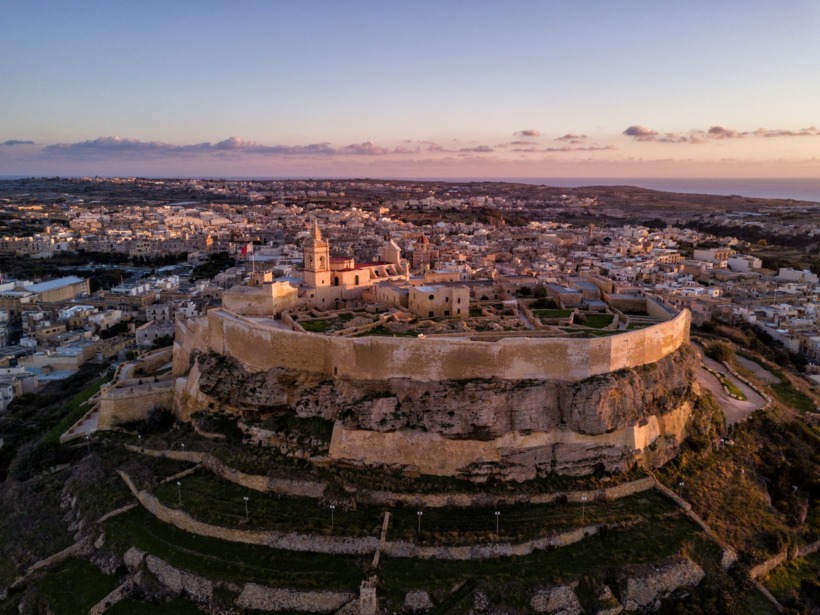A Green Island with a Soulful History
Gozo is a small island with a big story. Greener, calmer, and more authentic than its larger neighbor Malta. Strolls among historic landmarks, views from the cliffs, crystal-clear sea, and a welcoming atmosphere will instantly transport you to another world. Whether you’re seeking relaxation, culture, or nature – Gozo has it all to offer.
Dominant of Gozo with a View Across the Island
Cittadella
Cittadella, an ancient fortified city, stands out as the main landmark of Gozo thanks to its distinctive panorama and military architecture – a beacon visible from all over the island. People who lived here since prehistoric times left their mark and created this majestic complex, still visible today.
Cittadella is rich in military, architectural, and historical structures, while its open areas provide habitat for many rare animal and plant species. The site offers an ideal setting for quality experiences. A visit to Cittadella feels like stepping back in time and experiencing the past in a truly unforgettable way.

Spiritual and Architectural Gem
Xewkija Church
Xewkija is well known for its Rotunda Church dedicated to Saint John the Baptist. It is a major landmark of the town and attracts crowds of tourists and locals alike every year. It is the largest church on the island of Gozo, commissioned by Joseph D’Amato in 1971 on the site of an older church.
The dome, standing 75 meters tall, with a diameter of 27 meters and a circumference of 85 meters, is estimated to weigh around 45,000 tons and ranks among the largest in Europe. The Rotunda was consecrated on June 17, 1978. The interior is adorned with beautiful works of art, sculptures, and paintings. The floor and main altar are covered in prestigious marble.

A heritage thousands of years old
Ggantija Temples
As early as 3600 BC, the inhabitants of Gozo were building sophisticated stone structures, including the Ġgantija temples. These are among the oldest free-standing stone structures in the world. Their remains, which hold the status of a UNESCO World Heritage Site, can still be visited today in Ix-Xagħra.

A Place of Peace and Miracles
Basilica Ta’ Pinu
Not far from Dwejra Bay, nestled among the hills with a view of the sea, stands the majestic Ta’ Pinu Basilica – a pilgrimage site like no other on Gozo. It was built on the site of a chapel where, in 1883, a woman heard the voice of the Virgin Mary. After several miraculous healings, a magnificent church was constructed, completed in 1931 and visited by Popes John Paul II and Benedict XVI.
Inside, you’ll be enchanted by marble details, mosaics, and statues. Behind the basilica, you’ll find the original chapel and a stone path with the Stations of the Cross offering beautiful sea views – an ideal place for a peaceful walk and stunning photos.

Lorem ipsum
Torri ta’ Santa Maria on Comino Island
This massive defensive tower, built in 1618 by the Knights of Malta, was designed by architect Vittorio Cassar. It served as part of the coastal defense system and ensured communication between Malta and Gozo.
Standing 80 meters above sea level, the tower is 12 meters tall and its walls are up to 6 meters thick.
It is open to the public from April to October – on Wednesdays, Fridays, Saturdays, and Sundays from 10:30 AM to 3:00 PM, provided the flag is flying.

Culture and Celebrations
Gozo and Malta proudly showcase their rich history and cultural treasures. Neolithic temples are just the beginning of the island’s incredible heritage – something you simply must see! Be sure to visit the museums, stroll through fortified towns and discover the hidden melodies underground.
All year round, Gozo hosts a variety of cultural events. One of the highlights is the five-day carnival in February or March, followed by a spring classical music festival called Gaulitana. From late May to mid-September, you’ll find countless village feasts known as festas held in honor of patron saints. Towns are beautifully decorated, marching bands fill the streets, and the atmosphere is festive and welcoming.
In September, you can enjoy the Qala International Folk Festival, and in October, the Mediterranea Festival, which dives deep into Gozo’s history and cultural traditions.

